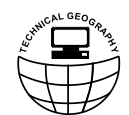Geographia Technica, Vol 20, Issue 2, 2025, pp. 205-217
A COMPARATIVE EVALUATION OF GEOREFERENCING TECHNIQUES IN UAV PHOTOGRAMMETRY: A CASE STUDY FROM THE CZECH REPUBLIC
Velile MOYO  , Michal KAČMAŘÍK
, Michal KAČMAŘÍK 
ABSTRACT: The study evaluates the positional accuracy of geospatial products generated using direct (GNSS RTK-based) and indirect (Ground Control Points-based) georeferencing methods in UAV photogrammetry. Using the DJI Mavic 3 Enterprise quadcopter, surveys were conducted at two contrasting sites in the Czech Republic: a flat agricultural area and rugged terrain in the area affected by a landslide. Acquired RGB image sets were processed using consistent photogrammetric workflows. Resulting digital elevation models (DEMs) and orthophoto mosaics were analyzed against independently measured control points. Vertical and horizontal accuracies were assessed through RMSE and haversine-based distance calculations. Findings indicate that while both georeferencing methods produced centimeter-level accuracy, indirect georeferencing using GCPs yielded better quality in height. For horizontal accuracy, the results slightly varied between the two areas. In the flat area, direct georeferencing produced slightly better accuracy than indirect georeferencing whereas in the hilly area, the GCP-based approach was slightly superior. The study concludes that while GCPs can still provide some benefits in the quality of georeferencing, RTK-enabled UAVs offer a practical alternative for rapid, efficient deployment in suitable contexts.
Keywords: UAV photogrammetry; Georeferencing; RTK; Digital Elevation Model; Orthomosaic

 Full article here
Full article here